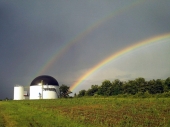Anyone have a good handle on what the ecologic impacts of poo in a septic system really are?
Location is western Wisconsin. I'm considering a bucket composting poo system, but it will cost me more money, and more energy, to bucket
compost my own poo, and I don't really think I'll miss the added compost, what with all the animals pooping everywhere already and organic matter in decay. The ONLY reason I would spend the additional money and energy on poo compost infrastructure, and the continual energy to make it function (carrying and washing buckets etc), would be to spare my environment my share of whatever the ecologic endgame of the septic sludge in theory hauled "away" happens to be, so, what is that? Bear in mind I'm pretty confident I legally have to hire a pumper to come to my home and pump the tank every so often, regardless of if I put any poo in there.
On an entirely different note, is a septic system unhappy when it doesn't get it's intended poo/pee for any reason? How about water lines, does absence of water flow at plumbed toilet stations (but with no toilet hooked up) cause any problems I should be concerned about, if switching to a toilet box with a bucket in it? I've shot myself in the foot before, with things that are designed to be used or otherwise start a downward slide (an automobile for example). Thank for any insight.









